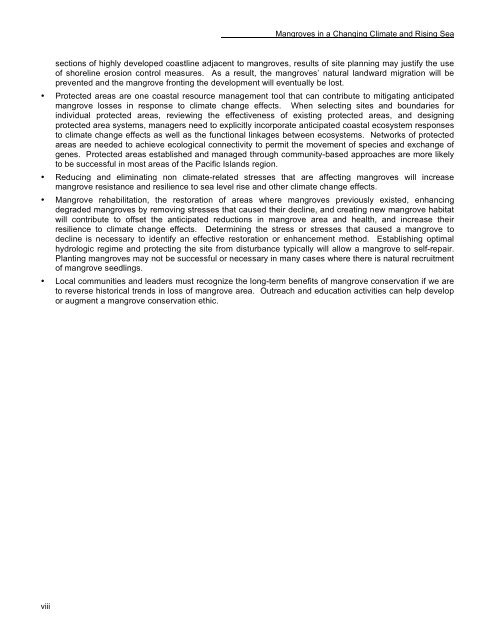Pacific Island Mangroves in a Changing Climate and Rising Sea
Pacific Island Mangroves in a Changing Climate and Rising Sea
Pacific Island Mangroves in a Changing Climate and Rising Sea
Create successful ePaper yourself
Turn your PDF publications into a flip-book with our unique Google optimized e-Paper software.
viii<br />
<strong>Mangroves</strong> <strong>in</strong> a Chang<strong>in</strong>g <strong>Climate</strong> <strong>and</strong> Ris<strong>in</strong>g <strong>Sea</strong><br />
sections of highly developed coastl<strong>in</strong>e adjacent to mangroves, results of site plann<strong>in</strong>g may justify the use<br />
of shorel<strong>in</strong>e erosion control measures. As a result, the mangroves’ natural l<strong>and</strong>ward migration will be<br />
prevented <strong>and</strong> the mangrove front<strong>in</strong>g the development will eventually be lost.<br />
• Protected areas are one coastal resource management tool that can contribute to mitigat<strong>in</strong>g anticipated<br />
mangrove losses <strong>in</strong> response to climate change effects. When select<strong>in</strong>g sites <strong>and</strong> boundaries for<br />
<strong>in</strong>dividual protected areas, review<strong>in</strong>g the effectiveness of exist<strong>in</strong>g protected areas, <strong>and</strong> design<strong>in</strong>g<br />
protected area systems, managers need to explicitly <strong>in</strong>corporate anticipated coastal ecosystem responses<br />
to climate change effects as well as the functional l<strong>in</strong>kages between ecosystems. Networks of protected<br />
areas are needed to achieve ecological connectivity to permit the movement of species <strong>and</strong> exchange of<br />
genes. Protected areas established <strong>and</strong> managed through community-based approaches are more likely<br />
to be successful <strong>in</strong> most areas of the <strong>Pacific</strong> <strong>Isl<strong>and</strong></strong>s region.<br />
• Reduc<strong>in</strong>g <strong>and</strong> elim<strong>in</strong>at<strong>in</strong>g non climate-related stresses that are affect<strong>in</strong>g mangroves will <strong>in</strong>crease<br />
mangrove resistance <strong>and</strong> resilience to sea level rise <strong>and</strong> other climate change effects.<br />
• Mangrove rehabilitation, the restoration of areas where mangroves previously existed, enhanc<strong>in</strong>g<br />
degraded mangroves by remov<strong>in</strong>g stresses that caused their decl<strong>in</strong>e, <strong>and</strong> creat<strong>in</strong>g new mangrove habitat<br />
will contribute to offset the anticipated reductions <strong>in</strong> mangrove area <strong>and</strong> health, <strong>and</strong> <strong>in</strong>crease their<br />
resilience to climate change effects. Determ<strong>in</strong><strong>in</strong>g the stress or stresses that caused a mangrove to<br />
decl<strong>in</strong>e is necessary to identify an effective restoration or enhancement method. Establish<strong>in</strong>g optimal<br />
hydrologic regime <strong>and</strong> protect<strong>in</strong>g the site from disturbance typically will allow a mangrove to self-repair.<br />
Plant<strong>in</strong>g mangroves may not be successful or necessary <strong>in</strong> many cases where there is natural recruitment<br />
of mangrove seedl<strong>in</strong>gs.<br />
• Local communities <strong>and</strong> leaders must recognize the long-term benefits of mangrove conservation if we are<br />
to reverse historical trends <strong>in</strong> loss of mangrove area. Outreach <strong>and</strong> education activities can help develop<br />
or augment a mangrove conservation ethic.

















